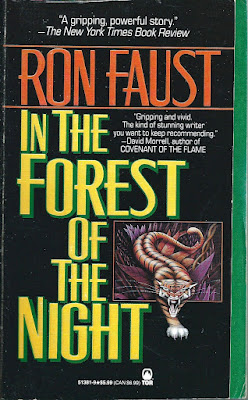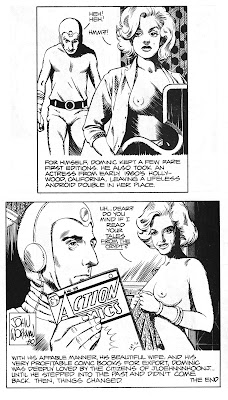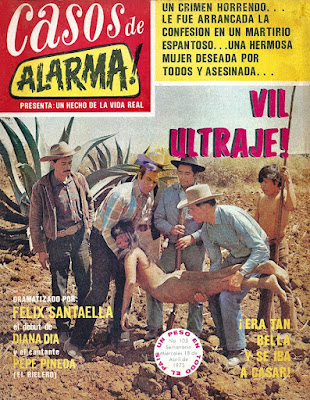May is No Place for Gringos Month !
Book Review: 'In the Forest of the Night' by Ron Faust
5 / 5 Stars
'In the Forest of the Night' first was published in 1993. This paperback edition (326 pp.) was published by Tor Books in April, 1994, and features cover art by Richard Andri.
Ron Faust (b. 1936) has published 15 novels between 1974 and 2013. Some of these feature the investigator 'Dan Shaw', and many are set in the southern US, the Caribbean, and Central and South America. 'Nowhere to Run' (1981) is the story of an American drifter who finds himself accused of murder while eking out a living in a Mexican resort town, and thus belongs to the 'No Place for Gringos' sensibility.
'In the Forest of the Night' is set in the early 1990s in an un-named Central American country. There is a civil war waging between the authoritarian government and a coalition of Marxist rebels. The American physician Martin Springer has gone South of the Border in order to minister to the medical needs of the rural population. However, this act of virtue is disregarded by the Marxistas, who decide to capture and execute him, allegedly for witnessing something the Marxistas would prefer be kept concealed.
As the novel opens, Springer is imprisoned in the bell tower of the Church of San Pedro de los Martires church in the impoverished town of Tepazatlan.......certainly no situation any gringo wants to be in. The time of his execution ? Well, próximamente, of course:
The morning was bright, none had ever been more purely brilliant, and yet Martin had difficulty seeing. It was like looking through another's eyeglasses, clear on the periphery but blurred in the center.........
A dog limped around the corner of the tower, a yellowish bitch nearly bald with mange. Its ribs and vertebrae were outlined against the skin. It halted and stood splay-legged for a moment, staring, and then, lowering its head and tail, slunk back around the tower.
Springer's wife, a beautiful blue-eyed blonde woman named Katherine, travels to the capital city in the hopes of arranging for her husband's release. She meets a dissipated American reporter named Dix, and a U.S. embassy staffer named Harley, who are not optimistic about her chances. And then there is Senor Jorge Cabeza de Vaca, '.....some sort of policeman, and very powerful in the government.' Transfixed with the thought of a mujer rubia as a supplicant for his graces, Senor Cabeza de Vaca assures Katherine he can free her husband. Soon. Very soon. Manana, in fact !
What a naive Katherine Springer doesn't realize is that South of the Border, the laws and proprieties observed in the United States do not apply. And Senor Cabeza de Vaca never grants favors without wanting something in return...........
I'm not giving away any spoilers to say that Martin Springer manages to evade death at the hands of the Marxistas. But that is hardly the end of his troubles, for he and his wife are going to discover that Central America is indeed No Place for Gringos...........
'Forest' is an entertaining thriller. The author uses a spare, declarative prose style in his depictions of the environs of the cities and countrysides where the story unfolds, and the actions of his large cast of characters. His dialogue passages are terse and to the point. As well, the political pontifications that occupy so much of another 'Central America is a Gringo Hell' novel, David Linsey's 'Body of Truth', are absent in 'Forest'; Faust does provide political observations, but these are infrequent, and couched with irony rather than tumid indignation.
The only fault I found in the narrative was that the advancement of the plot too regularly relied on rather stupid decision-making on the part of the lead characters. But maybe gringos get in trouble South of Border precisely because they are estupido.........?!
'Forest' features a motif not frequently found in gringo dramas: humor, this in the form of the boisterous colonel Felipe Fuerte, a rebel officer whose loyalty revolves around monetary rewards, rather than ideological fulfillment. Fuerte, as Martin Springer will discover, is a good man to have on your side when adversity presents itself.
The verdict ? 'In the Forest of the Night' is the best of the No Place for Gringos novels that I have read. It provides a believable portrait of what it is to be isolated and helpless in a country where caudillos hold power, and their slightest order must be obeyed. The closing chapters are genuinely suspenseful, all the more so because Faust never tips his hand as to the outcome. This is a book worth searching out.

































.jpg)























